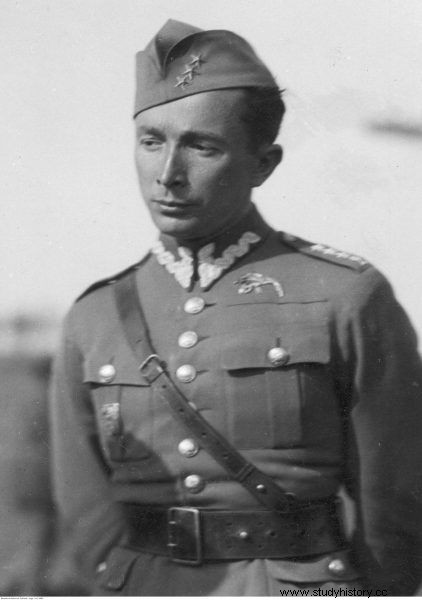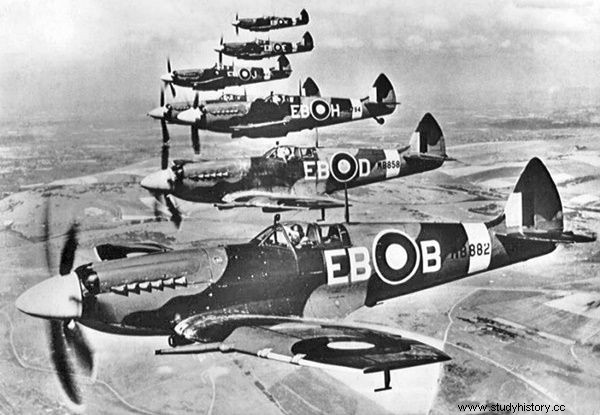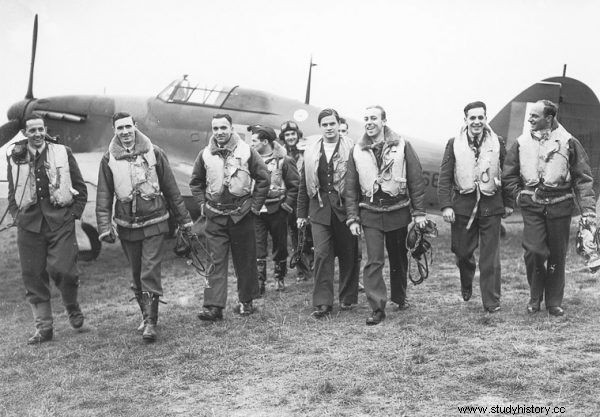It's easy to make a mistake in the air. Was the plane really shot down? Can the victory be ascribed to oneself or should it be shared with someone? Some of the doubts are answered in the archives of enemies. But this is only the beginning of wartime arithmetic ...
The debate about the true number of Polish air victories during World War II continues. More and more books appear, archives are being searched, Internet forums sparkle with the fire of discussion. And yet, as wrote aviation historian Piotr Sikora, with the present state of knowledge (...) [still] we are far from confirming most of our pilots' claims, even those that the Bajan Commission considered credible long ago. Why is it so difficult to list a certain number of kills? According to the researcher, this is influenced by several factors, for example:
Battle confusion and reporting the destruction of the same machine by several pilots and misinterpretation of the behavior of German rivals (diving does not always mean that the plane has crashed) and technical capabilities (a smoking bomber on one engine could often fly back to base in France).
Bajan's List
The first attempt at a comprehensive calculation of the losses inflicted on enemies was made just after the war. Of course, the summary concerned not only German but also Italian, Japanese and Soviet aircraft. The Historical Commission of the Polish Air Force has prepared a study entitled "Achievements of Polish fighter pilots in the Second World War". On March 25, 1946, they were approved by the liaison officer at the headquarters of the British Fighter Aviation Command, Colonel Jerzy Bajan.

Colonel Jerzy Bajan approved the "Achievements of Polish fighter pilots in the Second World War." In the photo from the 1930s as a captain of the Polish Army.
Based on the documents collected by the Historical Commission, the so-called "Bajan list" was created . It lists all Polish airmen whose reports regarding losses to enemy aviation during World War II have been confirmed. Documentation available at that time was used when assessing the airmen's reports.
The 1946 census remains the official list of victories of Polish fighter pilots to this day. It houses 441 Polish airmen and one Czechoslovakian - sergeant Josef František. Adding up their successes gives you an impressive 922 and 19/30 certain kills, 188 probable and 258 and 23/30 damage.
Where do fractions come from in calculations of this type? Often more pilots fired at one machine. When they were aware of it, the victory was shared among them. And so, if two airmen worked for them, each could later boast about "half" of the downed plane. If there were three of them - 1/3 was awarded to each. These fractions were later summed up by the pilots and hence, for example, the Krakow aviator, Second Lieutenant Jan Kremski, has a total of… 4 and 14/15 sure victory. To the honorable title of ace from 5 victories upwards, he was only 1/15 short of it.

However, it also happened that the pilots were not aware that they shared the merit of knocking down the enemy machine with others. In these cases, they reported being shot down separately, which gave them more wins (or perhaps a greater share of the win) than they actually achieved.
The enemy will tell you the truth
The figures established by the Bajan Commission were verified in the following years. When the archives of the war enemies were opened, it was possible to compare the number of victories reported by Poles with the losses demonstrated by their adversaries. As a rule, such comparisons of own sources with hostile sources resulted in lower results. For example, it is believed that in France, Poles shot down 50 and 9/10 enemy aircraft. 12 of these victories were awarded to fighters from 1/145 Squadron. Historian Bartłomiej Belcarz has recently reduced this number to 8.
According to the latest findings, the confirmed sum of victories of Poles and foreigners in Polish squadrons has also dropped. In 1946 it was judged to be 764 and 5/12 . This included 19 and 5/6 knocks made by Poles in American aviation, but some of those officially approved by the Americans were omitted. Meanwhile, according to historian Jacek Kutzner, a little less total of 742 and a quarter of the machines were shot down.

PZL P.11 in 1939. Among other things, such machines were used by Polish pilots in the September campaign when fighting the Luftwaffe.
Sometimes there are also attempts to increase the number of Polish air successes. This applies, for example, to the balance sheet of September 1939. According to the Bajan Commission, Polish airmen shot down 126 planes then. In 1991, the historian Jerzy Pawlak, however, counted as many as 147 victories. Unfortunately, not all additional submissions were positively verified later.
It is also worth adding that the post-war commission did not count the successes of Polish airmen in the USSR. That would be an additional 15 kills. Maybe it was finally decided that they should not be counted on the Poles' account? This would be indicated by the names of most of the winning pilots with Russian sounding.
Gold watch for Focke-Wulf
The problem with keeping accurate counts made it difficult to say with certainty when it was time to celebrate a "round" result. Nevertheless, such reports appeared in the press from time to time. This is what a 308 Squadron aviator described in his memoirs. Jerzy Główczewski:
We read in "Dziennik Polski" the great news that Polish pilot Henryk Pietrzak shot down a 500 German plane, counting from the beginning of the 1940s, that is, from the time when Poles started flying from England.

Shot down Focke-Wulf FW 190. This machine was to be the 500th prize of Polish airmen during World War II.
Pietrzak's success took place on Thursday, December 31, 1942. For knocking down the Focke-Wulf Fw 190, the aviator received a gold watch. Yet, if the Bajan commission's calculations were to be used, it might turn out that the gift belonged to someone else !
Round calculations and "pumping" of results, that is, overestimating one's own successes, appeared in all fighters. They were usually caused by excessive optimism. For example, at the height of the battle of Britain on August 15, 1940, British RAF pilots reported 185 kills. In the end, they were awarded “only” 76. The Luftwaffe documentation does not support even this lower figure. Reports a loss of 67 machines.
The problem of exaggerating one's own results also appeared on the German side. On August 15, their fighters reported that 74 RAF machines had been shot down. Meanwhile, the British lost 36 of them, of which only 25 in air combat. The Luftwaffe airmen themselves stated directly that the farther from Berlin, the easier it is to be successful . Many German airmen on the Eastern Front took advantage of this. The Russians were even less honest. During the Battle of the Kursk region, they inflated their successes by 1500 percent!

How effective were the spitfeire pilots?
No one was specifically chasing the "matchstick". After all, war propaganda needed heroes and successes. Only obvious frauds could not be taken off. Like when one of the Germans taking part in the struggle for Great Britain reported shooting down three Spitfires, although ... he returned to the base with a full set of ammunition. After his mechanic discovered the lie, the imposter was kicked out of the unit.
Pumping results? Not everywhere!
Airmen from 303 Squadron, the most effective Allied squadron fighting during the Battle of Britain . Since the clash, it was assumed that they had shot down 126 planes. Until today, this number is recognized by many historians. But there are also suggestions that the unit has only slightly more than 45 enemy machines ...
Those who want to reduce the number of Polish victories during the fight for Great Britain should remember that the first verification was carried out by the islanders themselves. They were watching the hands of Poles and other foreigners from "exotic" countries.

Our scythes were checked by, among others, Colonel Stanley Vincent. It was the commander of the base in Northolt, where 303 Squadron was stationed. In order to find out if the Polish pilots were exaggerating in assessing their successes, he flew with them on one of the sorties.
Luckily, our airmen encountered a German bombing expedition during this inspection. The British saw with his own eyes how the Poles smashed a tight array of bombers. What happened next? This is how the delighted Vincent described the whole situation:
They jumped (...) to the scattered machines and suddenly the air filled with flaming planes, parachutes and broken pieces of wings. It was so sudden it was deafening.

303 Squadron pilots surprised the British command.
The squadron airmen were so effective that the English colonel could not even join the action. He was probably a little sorry, because every time he tried to shoot a German, a Polish plane was cleaning him from his sight. After returning to the base, however, he had no doubts as to the truthfulness of the Polish reports: They really do what they say. Really!
Even such enthusiastic voices do not convince everyone. And there is no indication that the discussion on the actual number of Polish victories, be it in the Battle of Britain or in the entire Second World War, would end soon.
Literature:
- Jerzy B. Cynk, Polish Air Force at war. 1943-1945, AJ-Press 2002.
- Jerzy Główczewski, The last fighter pilot. Memories , Polish Scientific Publishers PWN 2017.
- Wacław Król, Dębliniacy with the code "PK", Publishing house MON 1984.
- Wacław Król, Polish aviation squadrons in Great Britain 1940-1945, Publishing house MON 1982.
- Jacek Kutzner, Victories of fighter pilots of the Polish Air Force in the West 1940-1945, Adiutor-Qlco 2007.
- Stefan Łaszkiewicz, From Cambrai to Coventry, Publishing house MON 1982.
- Łukasz Łydżba, Krakowski III / 2 Fighter Squadron, Vesper 2012.
- Jerzy Pawlak, Polish squadrons in the Defense War. September 1939, Publishing House of Communications and Communications 1991.
- Tymoteusz Pawłowski, Poles in the Battle of Britain , Wirtualna Polska 7/07/2015.
- Sławomir Sieradzki, Sky Lies, "Wprost" on February 23, 2003.
- Piotr Sikora, Polish aviation aces, Oficyna Wydawnicza Alma-Press 2014.
- Przemysław Skulski, Ace y skies 1939-1945, ACE Publication 1995.
- Przemysław Skulski, The Battle of Britain 1940, ACE Publication 1997.
- Mike Spick, Allied Fighter Aces, Bellona 2006.
- Grzegorz Śliżewski, Grzegorz Sojda, Skalski's Circus. A contribution to the monograph, ZP Grupa 2009.
- Adam Zamoyski, Forgotten squadrons. The fate of Polish airmen, Pulse 1995.
- Józef Zieliński, Polish aviation aces, Aviation Agency "Altair" 1994.
- Portal Polish Air Force in World War II.
Buy the book at a discount from the publisher's site

